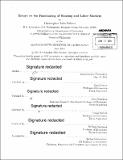Essays on the functioning of housing and labor markets
Author(s)
Palmer, Christopher John
DownloadFull printable version (13.90Mb)
Other Contributors
Massachusetts Institute of Technology. Department of Economics.
Advisor
David Autor, Jerry Hausman, Parag Pathak, and William Wheaton.
Terms of use
Metadata
Show full item recordAbstract
The first chapter consists of my job-market paper. The foreclosure rate of sub-prime mortgages increased markedly across 2003-2007 borrower cohorts-sub-prime mortgages originated in 2006- 2007 were roughly three times more likely to default within three years of origination than mortgages originated in 2003-2004. Many have argued that this surge in sub-prime defaults represents a deterioration in sub-prime lending standards over time. I quantify the importance of an alternative hypothesis: later cohorts defaulted at higher rates in large part because house price declines left them more likely to have negative equity. Using loan-level data, I find that changing borrower and loan characteristics explain approximately 30% of the difference in cohort default rates, with almost of all of the remaining heterogeneity across cohorts attributable to the price cycle. To account for the endogeneity of prices, I employ a nonlinear instrumental-variables approach that instruments for house price changes with long-run regional variation in house-price cyclicality. Control function results confirm that the relationship between price declines and defaults is causal and explains the majority of the disparity in cohort performance. I conclude that if 2006 borrowers had faced the same prices the average 2003 borrower did, their annual default rate would have dropped from 12% to 5.6%. The second chapter is joint with David Autor and Parag Pathak. Externalities from the attributes and actions of neighborhood residents onto the value of surrounding properties and neighborhoods are central to the theory of urban economics and the development of efficient housing policy. This paper measures the capitalization of housing market externalities into residential housing values by studying the sudden and largely unanticipated 1995 elimination of stringent rent controls in Cambridge, Massachusetts, which had previously muted landlords' incentives to invest in their properties and altered the assignment of residents to locations. Pooling administrative data on the universe of assessed values and transacted prices of all Cambridge residential properties between 1988 and 2005, we find that rent decontrol genrated substantial, robust price appreciation at decontrolled units and nearby never-controlled units, accounting for an estimated 30 percent of the $7.8 billion in Cambridge residential property appreciation during this period. The majority of this contribution is due to induced appreciation of never-controlled properties, while residential investments can explain only a small fraction of the total. The third chapter is joint with Denis Chetverikov and Bradley Larsen. We present a methodology for estimating the distributional effects of an endogenous treatment that varies at the group level when there are group-level unobservables, a quantile extension of Hausman and Taylor (1981). Standard quantile regression techniques are inconsistent in this setting, even if the treatment is exogenous. Using the Bahadur representation of quantile estimators, we derive weak conditions on the growth of the number of observations per group that are sufficient for consistency and asymptotic normality. Simulations confirm the superiority of this grouped instrumental variables quantile regression estimator to standard quantile regression. An empirical application finds that low-wage earners in the U.S. from 1990-2007 were significantly more affected by increased Chinese import competition than high-wage earners. We also illustrate the usefulness of the estimation approach with additional empirical examples from urban economics, labor, regulation, and empirical auctions. Chapter 1 Keywords: Mortgage Finance, Sub-prime Lending, Foreclosure Crisis, Negative Equity Chapter. 2 Keywords: Urban Economics, Residential Externalities, Rent Control, Price Regulations. Chapter 3 Keywords: Quantile Regression, Instrumental Variables, Panel Data, Wage Inequality, Import Competition. Chapter 1 JEL Classification: GOl, G21, R31, R38. Chapter 2 JEL Classification: D61, H23, R23, R31, R32, R38 Chapter 3 JEL. Classification: C21, C31, C33, C36, J30.
Description
Thesis: Ph. D., Massachusetts Institute of Technology, Department of Economics, 2014. Cataloged from PDF version of thesis. Includes bibliographical references (pages 194-206).
Date issued
2014Department
Massachusetts Institute of Technology. Department of EconomicsPublisher
Massachusetts Institute of Technology
Keywords
Economics.